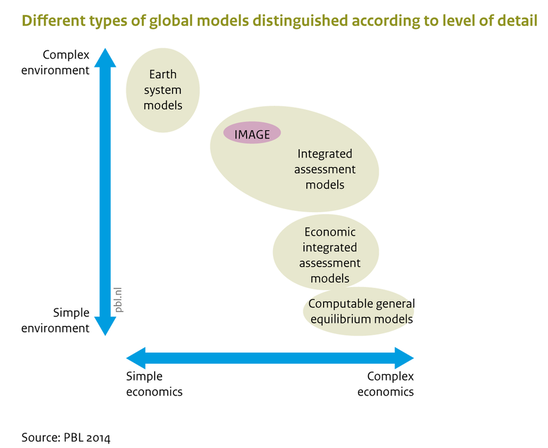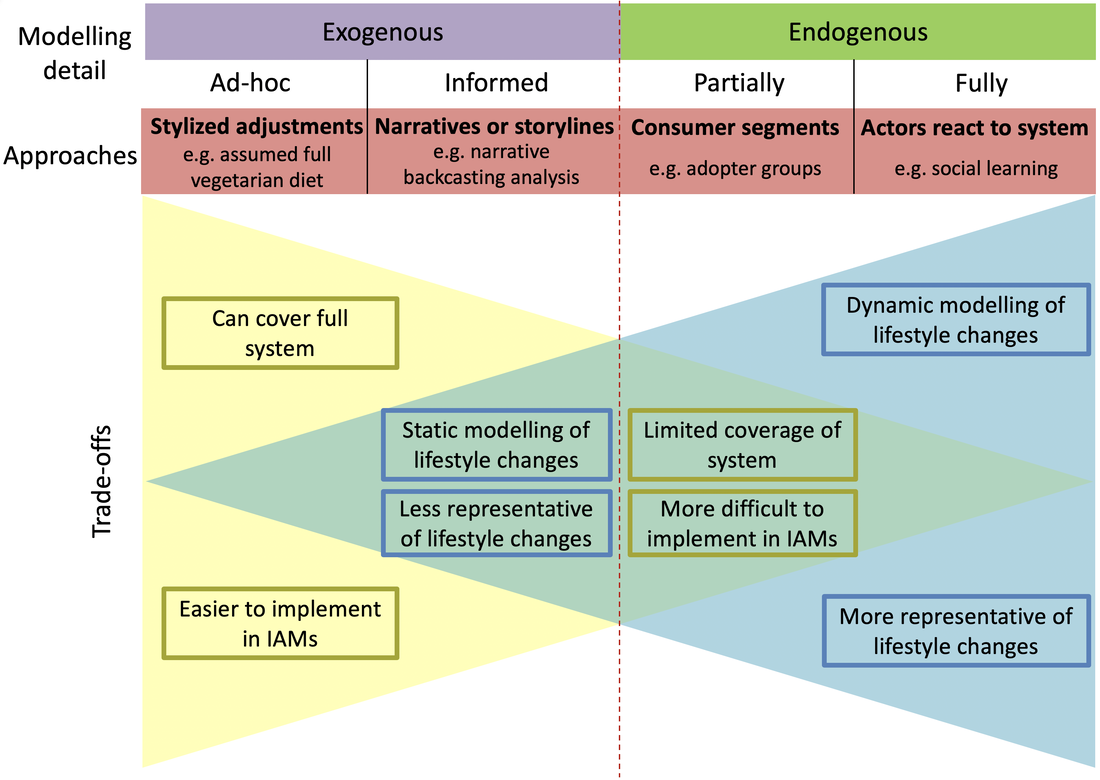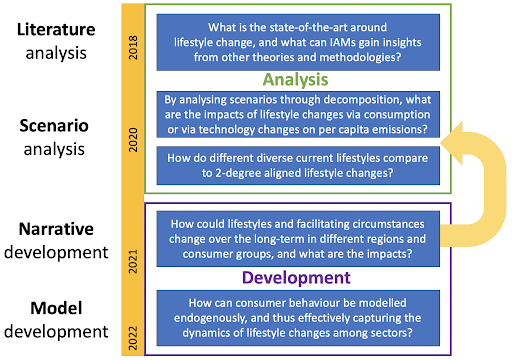The IMAGE Sustainable Lifestyles Project
This project aims to address the under-representation of lifestyle changes in global, model-based scenarios for advising policymakers on climate change mitigation strategies. This project is a multi-disciplinary collaboration between Utrecht University with the modelling and scenario development expertise, One Earth and Adelphi with sustainable lifestyle and consumption expertise. To ensure we accurately capture many different perspectives, we also actively engage with key stakeholders and decision-makers around the quantification of lifestyle changes.
We aim to combine information from detailed studies on consumer behaviour and global mitigation models – by translating the outcomes of detailed studies into scenario inputs for the integrated assessment model IMAGE. The opportunity for scaling lifestyle mitigation strategies increases with evidence-based clarification of the contribution of lifestyle interventions (in contrast to the stylized runs used so-far). The analysis allows us to estimate the environmental impact of sustainable behavior vis-à-vis business-as-usual using model studies and to engage IPCC and decision-makers as we develop the model. IMAGE also allows us to analyze the impacts of lifestyle change on staying within planetary boundaries in general (climate, biodiversity, land use, water). By improving the representation of lifestyle changes in mode, it will provide a more realistic indication of the mitigation potential, the role of different actors and the rate at which strategies can be implemented. Together with the stakeholders of this project, we will also improve understanding and communication on the possible impact of sustainable consumption patterns – both to show the effectiveness of lifestyle change oriented strategies and to use their feedback from action experiments in further improving the scenario set.
Of course, modelling is never the holy grail in itself, but it forms the basis for engaging in dialogue. Without a clear path and the will to put in the effort, the objectives can never be achieved. ~ Detlef van Vuuren "
What are Integrated Assessment Models?

Integrated Assessment Models (IAMs) are used to explore strategies for climate change mitigation and reduce global biodiversity loss, and inform decision-makers. IAMs have been used to support various international assessments, including IPCC assessments, UNEP’s Global Environment Outlooks, OECD’s Environmental Outlooks and the Millennium Ecosystem Assessment. The options considered in these models generally consist of energy efficiency improvements, changes in energy supply (i.e. increased use of renewable energy, nuclear power and carbon-capture-and-storage), reduction of non-CO2 emissions, and changes in land use. Based on the need of simplifications, the models that are used describe decision-processes in terms of cost-optimal choice of different technologies. This approach provides a useful reference for describing decisions and mitigation strategies for energy supply (such as investments in large-scale power plants).
On the “demand” side (future demand of energy, water and food), however, a more diffuse set of drivers plays a role related to behavior, technologies and activities. These factors are much more difficult to address in aggregated models. IAMs developed and evolved from different model classes with a specific disciplinary focus and entry points (see IAMC wiki). However, the common feature of all IAMs is their focus on the dynamics between Human and Earth systems to understand global environmental issues.
Among IAMs, there is a trade-off between detail and simplification. Adequate detail is needed to include all relevant processes in the systems according to up-to-date knowledge around these systems. Yet, with increased detail and thus complexity, it is difficult to ensure adequate transparency and explore uncertainties compared to more simplified representation of processes (see figure to see where IAMs fall in the simplicity vs detailed compared to other models).
On the “demand” side (future demand of energy, water and food), however, a more diffuse set of drivers plays a role related to behavior, technologies and activities. These factors are much more difficult to address in aggregated models. IAMs developed and evolved from different model classes with a specific disciplinary focus and entry points (see IAMC wiki). However, the common feature of all IAMs is their focus on the dynamics between Human and Earth systems to understand global environmental issues.
Among IAMs, there is a trade-off between detail and simplification. Adequate detail is needed to include all relevant processes in the systems according to up-to-date knowledge around these systems. Yet, with increased detail and thus complexity, it is difficult to ensure adequate transparency and explore uncertainties compared to more simplified representation of processes (see figure to see where IAMs fall in the simplicity vs detailed compared to other models).
The IMAGE Model
IMAGE addresses a set of global environmental issues and sustainability challenges (e.g. climate change, land-use change, biodiversity loss, modified nutrient cycles and water scarcity), by modelling interactions of human and natural systems. The model is most suitable to analyse dynamics over the long-term (e.g. up until 2100) and at mostly large scales (e.g. global). These dynamics include global and long-term issues such as climate change, or similar forms in many places making them global in character.
“IMAGE 3.0 is the latest version of the IMAGE framework models, and has the following features:
- Comprehensive and balanced integration of energy and land systems was a pioneering feature of IMAGE. Recently, other IAMs have been developed in similar directions and comprehensive IAMs are becoming more mainstream.
- Coverage of all emissions by sources/sinks including natural sources/sinks makes IMAGE appropriate to provide input to bio-geochemistry models and complex Earth System Models (ESMs).
- In addition to climate change, which is the primary focus of most IAMs, the IMAGE framework covers a broad range of closely interlinked dimensions. These include water availability and water quality, air quality, terrestrial and aquatic biodiversity, resource depletion, with competing claims on land and many ecosystem services.
- Rather than averages over larger areas, spatial modelling of all terrestrial processes by means of unique and identifiable grid cells captures the influence of local conditions and yields valuable results and insights for impact models.
- IMAGE is based on biophysical/technical processes, capturing the inherent constraints and limits posed by these processes and ensuring that physical relationships are not violated.
- Integrated into the IMAGE framework, MAGICC-6 is a simple climate model calibrated to more complex climate models. Using downscaling tools, this model uses the spatial patterns of temperature and precipitation changes, which vary between climate models.
- Detailed descriptions of technical energy systems, and integration of land-use related emissions and carbon sinks enable IMAGE to explore very low greenhouse gas emissions scenarios, contributing to the increasingly explored field of very low climate forcing scenarios.
- The integrated nature of IMAGE enables linkages between climate change, other environmental concerns and human development issues to be explored, thus contributing to informed discussion on a more sustainable future including trade-offs and synergies between stresses and possible solutions.” (PBL, 2014).





